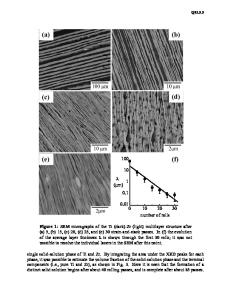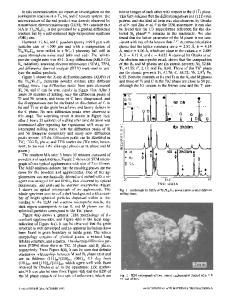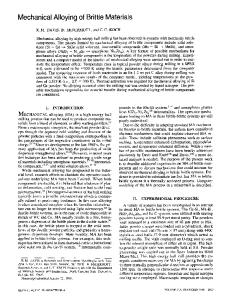Anomalous combustion effects during mechanical alloying
- PDF / 822,482 Bytes
- 6 Pages / 597.28 x 785 pts Page_size
- 2 Downloads / 376 Views
I.
INTRODUCTION
I N most solid-state chemical reactions, the reaction volume continually diminishes as the reactants become spatially separated by the products. The chemical kinetics of these reactions are therefore determined by the diffusion rates of the reactants through the product phases, [t,2,3~ and the activation energy for the reaction is that for the diffusion of the reactants through the products. t4] The reaction is therefore generally controlled by factors which influence diffusion rates. These include defect structures, defect densities, and local temperatures. We have previously shown [5-8] that the powder processing technique of mechanical alloying can significantly increase reaction rates in solids by minimizing the kinetic dependence on diffusion rates. This is achieved by the repeated fracture and welding of powder particles in the ball mill during mechanical alloying, thus continually bringing unreacted material into contact. This serves to dynamically maintain high reaction interface areas. Mechanical alloying causes highly exothermic redox reactions to proceed by the propagation of a mechanically induced combustion wave through the unreacted powders. [6,v,8] This is analogous to the thermally ignited self-propagating high-temperature synthesis (SHS) technique.J9] A similar mechanically induced effect has also been detected during the synthesis of metal chalcogenides.t~~ These authors claimed that the critical condition for combustion was dependent on attaining a minimum aggregate particle size. However, during mechanical alloying, a steady-state particle size is reached before the reactants are uniformly mixed. [~2] Other factors besides particle size must therefore control the reaction kinetics. The theoretical adiabatic temperature associated with a reaction, Tad, is often taken as a measure of the driving force. For those systems which combust, the precombustion milling period, tis, generally decreases with increasing Tad. This relationship arises because the local heat generated by the reaction is a function of Tad. Since
G.B. SCHAFFER, formerly Lecturer, Department of Mechanical Engineering, the University of Western Australia, is Lecturer, Department of Mining and Metallurgical Engineering, The University of Queensland, Qld, 4072, Australia. P.G. McCORMICK, Professor, is with the Department of Mechanical Engineering, the University of Western Australia, Nedlands, W.A., 6009, Australia. Manuscript submitted November 1, 1990. METALLURGICAL TRANSACTIONS A
diffusion and thus reaction rates depend on temperature, the overall rate of reaction is affected by the reaction enthalpy. The mechanical alloying action, whereby high reaction interface areas are maintained, does not therefore completely isolate the reaction kinetics from diffusional influences. The mechanical attrition of powder particles during milling generates large defect densities in individual particles, [~3] while nanometer sized crystallites are a direct consequence of the mechanical alloying of immiscible phases, t14] Both f
Data Loading...










